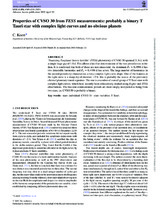| dc.contributor.author | Koen, C. | |
| dc.date.accessioned | 2021-02-08T12:47:28Z | |
| dc.date.available | 2021-02-08T12:47:28Z | |
| dc.date.issued | 2020 | |
| dc.identifier.citation | Koen, C. (2020). Properties of CVSO 30 from TESS measurements: probably a binary T Tauri star with complex light curves and no obvious planets. Monthly Notices of the Royal Astronomical Society, 494(3), 4349–4356 | en_US |
| dc.identifier.issn | 1365-2966 | |
| dc.identifier.uri | https://doi.org/10.1093/mnras/staa1038 | |
| dc.identifier.uri | http://hdl.handle.net/10566/5866 | |
| dc.description.abstract | ‘Transiting Exoplanet Survey Satellite’ (TESS) photometry of CVSO 30 spanned 21.8 d, with a single large gap of 1.1 d. This allows alias-free determination of the two periodicities in the data. It is confirmed that both of these are non-sinusoidal: the dominant P1 = 0.4990 d has two detectable harmonics and P2 = 0.4486 d has seven. The large number of harmonics in the second periodicity characterizes a very complex light curve shape. One of the features in the light curve is a sharp dip of duration ∼2 h: this is probably the source of the previously claimed planetary transit signature. The star is a member of a small group of T Tauri stars with complex light curves, which have recently been exhaustively studied using Kepler and TESS observations. The two non-commensurate periods are most simply interpreted as being from two stars, i.e. CVSO 30 is probably a binary. | en_US |
| dc.language.iso | en | en_US |
| dc.publisher | Oxford University Press | en_US |
| dc.subject | Stars: individual: CVSO 30 | en_US |
| dc.subject | Stars: variables: T Tauri 1 INTRODUCTION | en_US |
| dc.subject | Stellar rotation period | en_US |
| dc.subject | Sinusoidal | en_US |
| dc.title | Properties of CVSO 30 from TESS measurements: probably a binary T Tauri star with complex light curves and no obvious planets | en_US |
| dc.type | Article | en_US |

